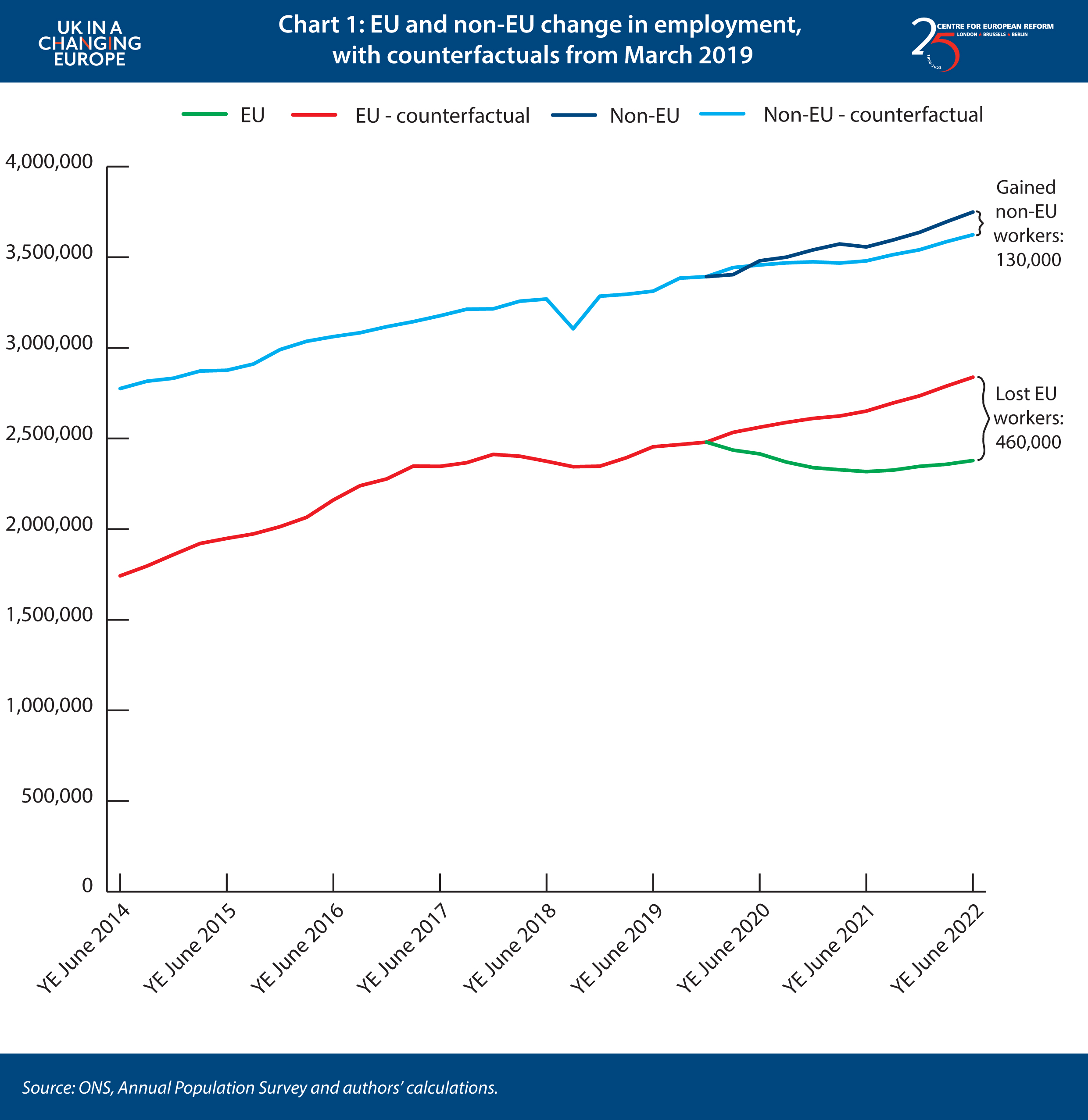
Early impacts of the post-Brexit immigration system on the UK labour market
The end of the free movement has led to a shortfall of around 330,000 workers in Britain. Most are in less-skilled sectors of the economy.
The free movement of EU citizens was at the centre of the Brexit campaign, and concern about high net immigration from Europe in the years before the Brexit vote was one of the main reasons why Leave won the referendum. Yet the government has enacted a relatively liberal immigration system to replace free movement. Immigration was becoming more popular even before 2016, with a growing plurality of British people agreeing since then that immigration has had a positive impact on the country. And in the aftermath of the pandemic, big labour shortages in health and social care, transport and hospitality have led some Leave-supporting business figures like Lord Wolfson of Next, a clothing retailer, and Tim Martin of Wetherspoons pubs to call for further liberalisation.
Now that pandemic restrictions have been over for a year, and the new immigration system has been in force for two, it is possible to make some early estimates of the impact of the new immigration regime on the British labour market. This assessment is important given the labour shortages that the UK is facing. Britain is the only member of the G7 whose employment rate in the third quarter of 2022 was lower than its pre-pandemic level. There are more than 500,000 more people who are economically inactive than before the pandemic, because they have either retired early or are unable to work because of illness or disability.
Meanwhile, many foreign nationals left the UK during the pandemic, and fewer arrived, fuelling the argument that the end of free movement contributed to labour shortages and inflation. But the Office for National Statistics estimates that in the year to June 2022 net immigration was 504,000, prompting Rishi Sunak to commit to bringing the number down.
To cut through this confusion, we estimate how many EU and non-EU workers would have been in employment if free movement had not ended and Britain’s immigration laws had remained as they were before the new system started in January 2021. We then compare that counterfactual to the out-turns, as measured by the Annual Population Survey. By June 2022, there was a significant shortfall of around 460,000 EU-origin workers, partly but not wholly compensated for by an increase of about 130,000 non-EU workers. The net loss of workers – around 330,000 – is 1 per cent of the labour force.

The large shortfall of non-UK workers is mostly in sectors that disproportionately employ less-skilled workers. Table 2 shows the results of the same estimation above, but at a sectoral level. There are very large shortfalls of EU-origin workers in:
- Transportation and storage: around 128,000, which is around 8 per cent of total employment in that sector
- Wholesale and retail: 103,000 – 3 per cent of employment
- Accommodation and food: 67,000 – 4 per cent of employment
- Manufacturing: 47,000 – 2 per cent of employment
- Construction: 46,000 – 2 per cent of employment
- Administration and support: 32,000 – 2 per cent of employment
All this adds up to a big fall in labour supply to less-skilled sectors of the economy. In hospitality and administration, there are sizeable but smaller shortfalls in non-EU-origin workers too. However, in general, less-skilled workers from outside the EU held steady in those sectors. And in more skilled sectors, such as healthcare, education and ICT, an increase in non-EU workers more than compensated for losses of those from the EU.

A fuller discussion of our method and data limitations is available in our working paper, published here. Briefly, we calculate the average growth rate in the workforce, by region of origin (UK/EU/non-EU), for the 2014-19 period, using the Annual Population Survey. We assume, for the purposes of our counterfactual, that growth rates in the non-UK born workforce would have followed a similar trajectory to that of the UK-born workforce. That is, if average growth in UK-origin employees fell by 1 percentage point in the post-pandemic period compared to the pre-pandemic period, then we assume that, absent changes to the migration system, the 2014-19 growth rate in EU and non-EU employment would have also fallen by 1 percentage point. Given the unreliability of the data during the pandemic, we ignore 2020 and 2021 for the purpose of constructing the trends prevailing prior to the introduction of the new system. Note that this does not ignore the continuing impact of the pandemic – rather, it assumes that there is no marked differential impact on labour demand between UK and non-EU workers by September 2022.
There are three important uncertainties about our estimates.
First, our method accounts for labour demand, because we assume that if UK employment fell, then the growth in EU and non-EU employment would have fallen equivalently. But the method does not account for labour supply; prospective EU workers might not have come to the UK even if it had maintained free movement, given labour shortages in other European countries after the pandemic.
Second, a big part of the increase in large net immigration after the pandemic was via non-work-related routes. There were big inflows of refugees from Ukraine, Hong Kong residents with British National Overseas passports, and students. Many of these people will enter employment over time, especially because the government has made it easier for foreign students to work in the UK after their courses have ended.
Third, the new immigration system will take time to bed in. Over half of UK jobs are eligible to be filled by immigrants under the system’s salary rules. More employers might sponsor immigrant workers in the future, if it becomes clear that they will not be able to fill roles with people who are already in the country. Many EU workers who have left the UK have the right to work under the EU settlement scheme, and may return to Britain over time.
What, if anything, do our estimates mean for the immigration policy debate? First, at least at present, the end of free movement is contributing significantly to labour shortages in less-skilled sectors of the economy and the new immigration system is not liberal enough to compensate. Minimum salary thresholds – which immigrants must earn to be given a visa – have been reduced, and the labour market test has been withdrawn: employers no longer have to advertise jobs to UK residents before bringing in workers from overseas. Employers in less-skilled sectors can respond to the end of free movement by raising wages and prices, by reducing production, or by investing in automation. If this government, or future ones, decide that higher prices or less production are a problem in particular sectors, they could make it easier for immigrants to move to the UK for work, especially by reducing the cost of visas and reducing – or eliminating – the ‘immigration health surcharge’, a tax on visa-holders. The government has already significantly relaxed visa conditions for workers in health and social care, and exempted those workers from the health surcharge, which has resulted in a big rise in visas issued (albeit not enough to compensate for the number of workers already in the UK who have decided to leave the NHS).
Overall, the new system is working broadly as Leave advocates promised. EU citizens no longer have the automatic right to work in the UK and must apply for visas alongside people from the rest of the world. The conditions of the new system, while liberal, are too onerous to compensate for the loss of free movement in low-skilled sectors of the economy, which has led to labour shortages. We do not yet know how employers are responding to these shortages, and it will take time for that adjustment to happen, but some combination of higher wages and prices and less output is likely, especially in work that is hard to automate.
Jonathan Portes is professor of Economics, King’s College London and a senior fellow at UK in a Changing Europe and John Springford is deputy director of the Centre for European Reform.



Comments
Add new comment